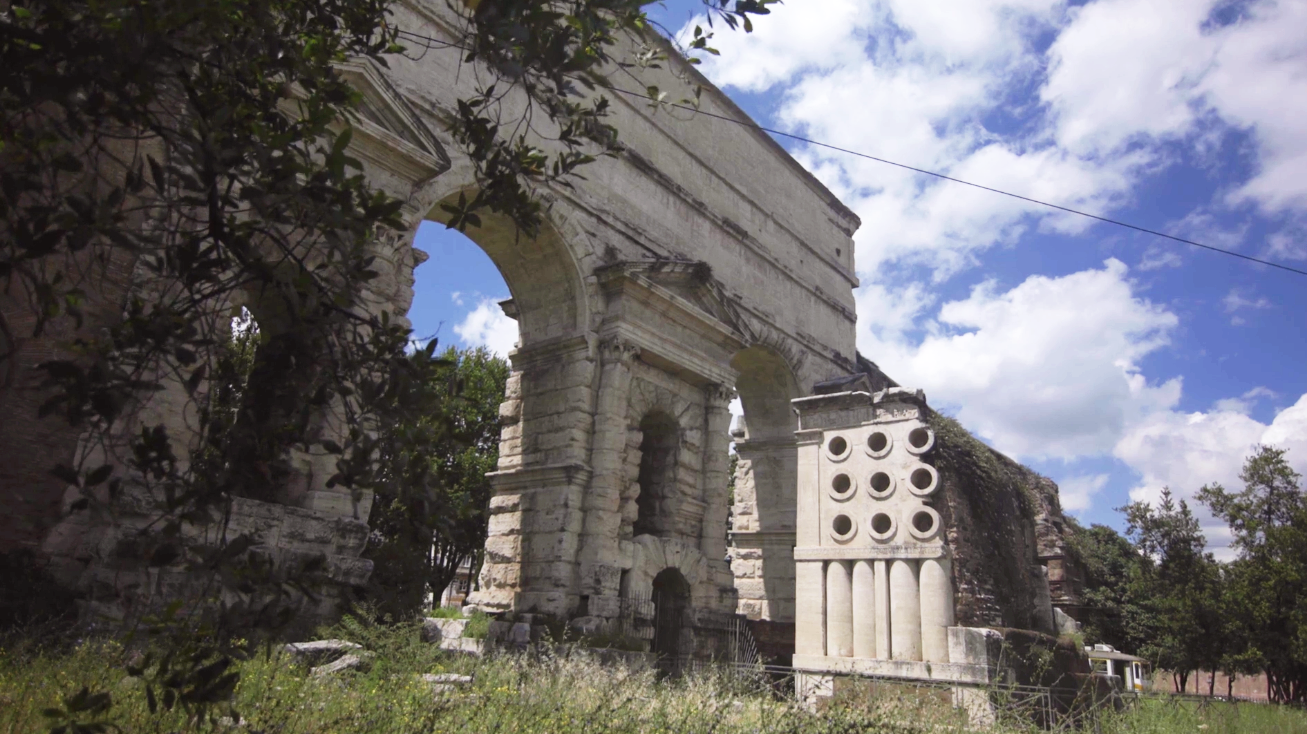Tombs

Share this step
Like many communities, Rome restricted burials to the area outside the city (in Rome’s case, to beyond a sacred boundary called the Pomerium).
A very few exceptions were granted to great public figures, and as the city expanded some earlier tombs found themselves marooned within the new boundary; but by and large, burial outside the city was the norm. Over time the city’s arterial roads were lined with tombs jostling for position and trying to catch the eye of the passer-by: though the Romans had no universally shared conception of ‘the’ afterlife, there seems to have been a general desire to be remembered in death. Building a noticeable tomb with a prominent inscription was a good starting point, and for ambitious Romans used to a lifetime of ostentatious competition, the grave provided a final opportunity to boast. The baker’s tomb, which we encounter in the next Step, is a particularly striking example, and Professor Peter Kruschwitz’s interview sheds light on other interesting examples.
In the republican period, aristocratic funerals could be lavish affairs with a strong message of family pride. Here is a famous description by the Greek historian Polybius:
Whenever any of their prominent men dies, as part of his funeral he is carried with all his adornment into the forum to the so‑called rostra, sometimes conspicuous in an upright posture, or (more unusually) reclined. With all the people standing round, an adult son, if he has left one and he happens to be present, or if not someone else from his family mounts the rostra and speaks about the virtues and achievements of the deceased. In so doing it follows that the multitude are reminded of these deeds and have them brought before their sight, so that not only those who shared in those deeds but also those not connected to them, come to such a pitch of sympathy that the loss seems to be not a private matter for the mourners, but for the people as a whole. After this they bury the dead and perform the customary ceremonies, and then place the image of the deceased in the most conspicuous place in the house, putting a little wooden shrine around it. This image is a mask, bearing the most exact likeness both in its moulding and in its outline. These images they display at public sacrifices, and decorate them carefully, and when someone else from the family dies they take them to the funeral, putting them on men who seem the most similar to each individual in size and general appearance. These men wear togas, bordered with purple if the deceased was a consul or praetor, completely purple if he was a censor, and golden if he had celebrated a triumph or won similar achievements. These men ride in chariots and are preceded by the rods and axes and the other symbols which accompany high office, suited to whatever each man had achieved in the state while alive. When they come to the rostra they all sit down on ivory chairs of office, and there could not be a sight more fine or welcome for a young man ambitious for reputation and virtue. For who would not be inspired to see the images of men renowned for their virtue all together and seemingly alive and breathing? What sight could be finer than this?Polybius, 6.53.8
Figure 1: The pyramid tomb of Cestius, englobed in the later Aurelianic Wall circuit near the Porta Ostiensis. Outside the walls, humbler tombs crowd along the Via Ostiensis, the road to Rome’s harbour town
Figure 2: A digital reconstruction of Hadrian’s (left) and Augustus’ (right) Mausoleums. © Dr Matthew Nicholls, University of Reading, 2017.
Figure 3: Detail from the baker’s tomb. A carving of people working in a bakery. © University of Reading
Figure 4: Simple Roman tombstones mounted on a wall. ©University of Reading
Once when he was eating his breakfast a stray dog brought in a human hand from the crossroads and laid it under his tableSuetonius, Life of Vespasian 5.
Share this
Rome: A Virtual Tour of the Ancient City


Reach your personal and professional goals
Unlock access to hundreds of expert online courses and degrees from top universities and educators to gain accredited qualifications and professional CV-building certificates.
Join over 18 million learners to launch, switch or build upon your career, all at your own pace, across a wide range of topic areas.
Register to receive updates
-
Create an account to receive our newsletter, course recommendations and promotions.
Register for free







